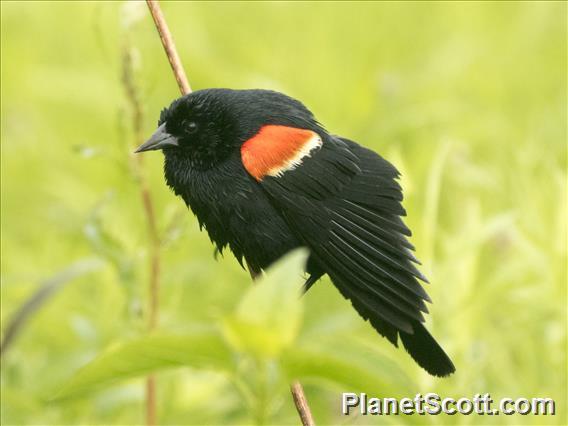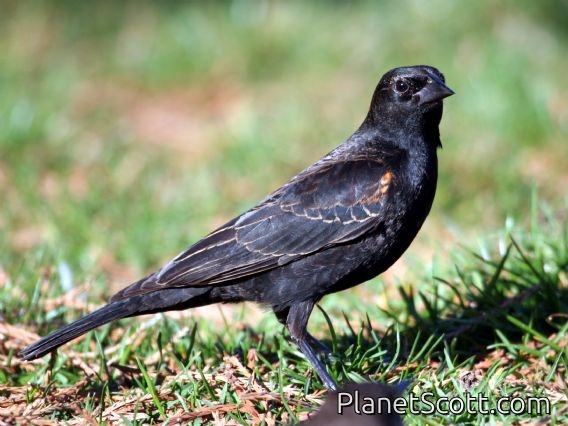Red-winged Blackbird (Agelaius phoeniceus)

Red-winged Blackbird (Agelaius phoeniceus)

Red-winged Blackbird (Agelaius phoeniceus) Juvenile


×



Red-winged Blackbird (Agelaius phoeniceus)

Red-winged Blackbird (Agelaius phoeniceus) Juvenile
About Red-winged Blackbird (Agelaius phoeniceus)
- Kingdom: Animals
- Phylum: Chordates
- Class: Birds
- Order: Perching Birds
- Family: American Blackbirds and Orioles
The red-winged blackbird is a passerine bird of the family Icteridae found in most of North America and much of Central America. It breeds from Alaska and Newfoundland south to Florida, the Gulf of Mexico, Mexico, and Guatemala, with isolated populations in western El Salvador, northwestern Honduras, and northwestern Costa Rica. It may winter as far north as Pennsylvania and British Columbia, but northern populations are generally migratory, moving south to Mexico and the Southern United States.
Source: Wikipedia
Trips
Visits
-
1977-06-01
Crabtree Nature Center, United States of America -
2006-04-16
Kern National Wildlife Refuge, United States of America -
2006-04-19
Candlestick Park, United States of America -
2007-01-01
Garfield Park, United States of America -
2007-06-14
Cape May Point State Park, United States of America -
2009-05-05
Elgin - Bluff Spring Fen, United States of America -
2009-05-08
Burnidge Forest Preserve, United States of America -
2009-05-09
Nelson Lake Forest Preserve, United States of America -
2009-06-01
Redwood Valley, United States of America -
2010-01-03
Sacramento National Wildlife Refuge, United States of America -
2010-02-21
Lerma Marshes, Mexico -
2010-06-25
Elgin - Bluff Spring Fen, United States of America -
2010-10-30
Miller Meadow Forest Preserve, United States of America -
2011-05-29
Del Puerto Canyon and Mines Road, United States of America -
2012-04-14
Heron's Head Park, United States of America -
2012-06-03
Nellsville Boardwalk, United States of America -
2012-07-08
Necedah NWR, United States of America -
2012-07-09
Sax-Zim Bog, United States of America -
2012-07-09
Tamarack Lake, United States of America -
2012-07-10
Bluestem Prairie, United States of America -
2012-07-10
170th St , United States of America -
2012-07-10
Arrowwood NWR, United States of America -
2012-07-10
Chase Lake NWR, United States of America -
2012-07-11
McKenzie Slough, United States of America -
2012-07-12
Yellowstone National Park, United States of America -
2012-09-19
Golden Gate Park - North Lake, United States of America -
2012-09-30
Golden Gate Park - Stow Lake, United States of America -
2013-03-04
John Heinz NWR at Tinicum (IBA), United States of America -
2013-03-07
Spring Valley Nature Sanctuary, United States of America -
2013-03-17
Lake Merced , United States of America -
2013-03-30
Heron's Head Park, United States of America -
2013-04-14
Austin, United States of America -
2013-04-17
Brazoria NWR (UTC 108), United States of America -
2013-04-19
Anahuac NWR (UTC 049), United States of America -
2013-04-20
Attwater Prairie Chicken National Wildlife Refuge, United States of America -
2013-04-21
Alemany Community Garden, United States of America -
2013-05-12
Redwood Valley, United States of America -
2013-11-29
Lake Merced , United States of America -
2014-02-16
Golden Gate Park - North Lake, United States of America -
2014-02-22
Santa Fe Grade, United States of America -
2014-03-08
Tule Elk State Reserve, United States of America -
2014-03-15
Alemany Community Garden, United States of America -
2014-04-06
Delta Meadows State Park, United States of America -
2014-05-09
Rodeo, United States of America -
2014-05-26
Heron's Head Park, United States of America -
2014-06-01
India Basin Shoreline Park, United States of America -
2014-06-15
Golden Gate Park - North Lake, United States of America -
2014-09-23
Redwood Valley, United States of America -
2014-10-02
Golden Gate Park - San Francisco Botanical Garden, United States of America -
-
2015-01-04
Panoche Valley, United States of America -
-
-
-
-
-
-
-
-
-
-
-
-
-
-
-
-
-
-
-
-
-
-
-
-
-
-
-
-
-
-
-
-
-
-
-
-
-
-
-
-
-
-
-
-
-
-
-
-
-
-
-
-
-
-
-
-
-
-
-
-
-
-
-
-
-
-
-
-
-
-
-
-
-
-
-
-
-
-
-
-
-








